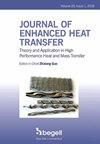一种结合主动(压电)和被动(微结构)部分流动-沸腾方法的稳定高热流密度介质冷却
IF 1.5
4区 工程技术
Q3 ENGINEERING, MECHANICAL
引用次数: 0
摘要
在毫米级热交换器的微结构沸腾表面/区域内,通过超声加热与微尺度成核气泡相关的微层,可以实现可控的爆炸性汽化速率增长。这些气泡是由Novec 3M的649,HFE(氢氟醚)-7000 (3M™Novec™7000工程流体产品信息,2022)的饱和部分流沸腾操作产生的。实验采用多层编织铜网形成微结构沸腾表面/区域及其纳/微尺度振幅超声(~1 - 6 MHz)和声波(<由一对非常薄的超声波压电换能器(称为压电换能器)引起的振动,这些换能器被放置在散热器外部并被驱动。超声波频率用于次结构微振动,而较低的声波频率用于辅助气泡去除和液体填充过程的合适谐振结构微振动。流动和压电驱动控制允许传热系数(HTC)值增加约5倍-从约9000 W/m2-°C(无压电情况下)到50000 W/m2-°C,代表性热通量约为25 W/cm2。部分沸腾的方法被设计成导致大约分离的蒸汽和液体流动(0.4-0.6范围出口质量)的5厘米x 1厘米x 5毫米流道的两个出口端口。此外,当前临界热通量(CHF)值(~70 W/cm2)的显著增加是可能的,并将在其他地方报道。产生纳米/微米振幅振动所消耗的电能很小(<3%)按设计(<3.5 W用于125 W的散热本文章由计算机程序翻译,如有差异,请以英文原文为准。
A Combined Active (Piezos) and Passive (Microstructuring) Partial Flow-Boiling Approach for Stable High Heat-Flux Cooling with Dielectric Fluids
Controlled but explosive growth in vaporization rates is made feasible by ultrasonic heating of the microlayers associated with micro-scale nucleating bubbles within the microstructured boiling surface/region of a millimeter scale heat exchanger. Such bubbles arise from saturated partial flow-boiling operations of Novec 3M’s 649, HFE (hydrofluoroether)-7000 (3M™ Novec™ 7000 Engineered Fluid Product Information, 2022). Experiments use layers of woven copper mesh to form a microstructured boiling surface/region and its nano/micro-scale amplitude ultrasonic (~1 - 6 MHz) and sonic (< 2 kHz, typically) vibrations – induced by a pair of very thin ultrasonic Piezoelectric-transducers (termed Piezos) that are placed and actuated from outside the heat-sink. The ultrasonic frequencies are for sub-structural micro vibrations whereas the lower sonic frequencies are for suitable resonant structural micro-vibrations that assist in bubble removal and liquid filling processes.
The flow and the Piezos’ actuation control allow an approximately 5-fold increase in heat transfer coefficient (HTC) value – going from about 9000 W/m2-°C (no Piezos case) to 50000 W/m2-°C at a representative heat flux of about 25 W/cm2. The partial boiling approach is designed to lead to approximately separated vapor and liquid flows (with 0.4-0.6 range exit quality) out of the 5 cm x 1 cm x 5 mm flow channel’s two exit ports. Further, significant increases to current critical heat flux (CHF) values (~70 W/cm2) are possible and are to be reported elsewhere. The electrical energy consumed for generating nano-/micro-meter amplitude vibrations is small (< 3 %) by design (< 3.5 W for 125 W heat remov
求助全文
通过发布文献求助,成功后即可免费获取论文全文。
去求助
来源期刊

Journal of Enhanced Heat Transfer
工程技术-工程:机械
CiteScore
3.60
自引率
8.70%
发文量
51
审稿时长
12 months
期刊介绍:
The Journal of Enhanced Heat Transfer will consider a wide range of scholarly papers related to the subject of "enhanced heat and mass transfer" in natural and forced convection of liquids and gases, boiling, condensation, radiative heat transfer.
Areas of interest include:
■Specially configured surface geometries, electric or magnetic fields, and fluid additives - all aimed at enhancing heat transfer rates. Papers may include theoretical modeling, experimental techniques, experimental data, and/or application of enhanced heat transfer technology.
■The general topic of "high performance" heat transfer concepts or systems is also encouraged.
 求助内容:
求助内容: 应助结果提醒方式:
应助结果提醒方式:


